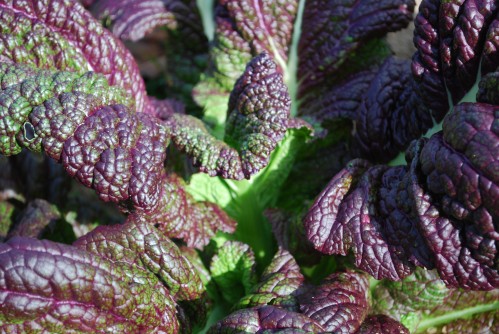Meet A Magnificent Mustard
 If you like spring greens, you will love to grow and cook with the asian mustard, Red Giant, Brassica juncea. Easily started by seed, it is a cool season annual which is slightly peppery in taste with magnificent green to dark purple textured leaves. Although it is "cold and bolt" tolerant, if allowed to flower, it has incredible yellow flowers that emerge as a tall spike out of its center, as a final encore.
If you like spring greens, you will love to grow and cook with the asian mustard, Red Giant, Brassica juncea. Easily started by seed, it is a cool season annual which is slightly peppery in taste with magnificent green to dark purple textured leaves. Although it is "cold and bolt" tolerant, if allowed to flower, it has incredible yellow flowers that emerge as a tall spike out of its center, as a final encore.
I have to admit I was first drawn to Red Giant mustard for its magnificent beauty. At different times of the day, it even appears to have a copper glow about it. I bought seeds to make a winter to spring border in my kitchen garden, or potager. It is equally striking in a landscape planting, or even paired with the wonderful ornamental cabbage and kale in a cool-weather container design.
A part of the Mustard family, and thought to be originally from India, the asian mustard, Red Giant, is one of the most popular asian mustards. It is quite different in taste and texture from American mustards, you might have grown. It is extremely versatile, when it is harvested, how it is harvested, and how it is prepared. Do you like spring greens, harvest the young whole plants early, at 20 days for your spring lettuce and mesclun mix. Do you like Asian stir fry, take one or two mature leaves at a time for your recipe, and the plant will continue to grow. Try it as a replacement for chard in your bean soups, julienned, or a substitute for spinach in your quiche. It is nutritionally packed with abundant amounts of vitamin A, C, B vitamins, calcium, and more.
Depending on your climate, you can plant it in the fall, spring, or late winter. It prefers full sun, and light moist fertile-mulched soils. Seeds germinate in 1-2 weeks, young plants can be harvested at 20 days, mature plants at 40 days. For a continuous crop, you might want to sow seeds every three weeks in the spring. I find that it "volunteers" easily for me, and my chickens reap those tasty benefits.
At nurseries, I often see asian mustard, Red Giant, in mesclun mixes, rather than sold by itself. There are many seed companies who have it available online. I first purchased my asian mustard, Red Giant, from the fabulous seed company, Botanical Interests, located in Broomfield, Colorado. Their website is www.botanicalinterests.com.
Do you normally grow mustard in your vegetable garden? What is your favorite way of preparing it? Please share your comments.